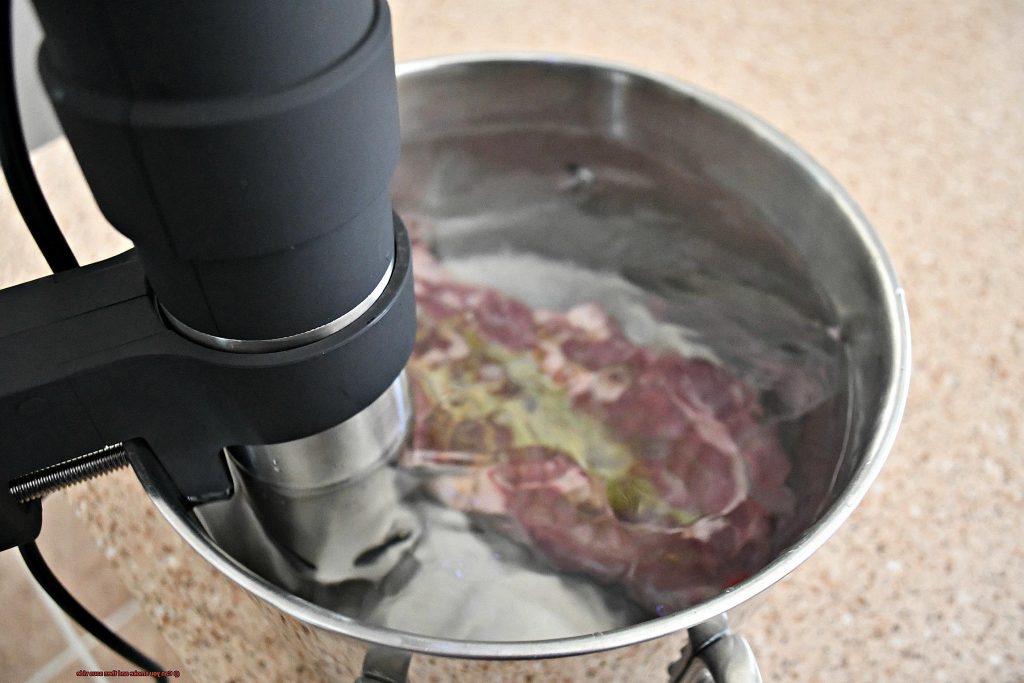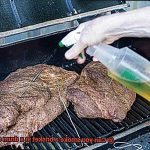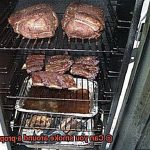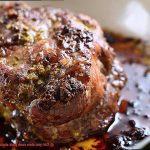Are you a foodie who loves to experiment with different cooking techniques? Do you crave the smoky flavor that only comes from grilling or smoking your food? And are you also a fan of sous vide cooking, which produces perfectly cooked meat every time? If you answered yes to all of these questions, then you’re in for a treat because today we’re tackling the question: can you smoke and then sous vide?
Smoking and sous vide are two very different methods of cooking, but when combined, they can create a culinary masterpiece. Smoking involves exposing food to smoke from burning wood or charcoal, while sous vide is all about cooking food in a sealed bag at an exact temperature in a water bath. The result? A juicy, tender piece of meat with an irresistible smoky flavor.
But before you get too excited about trying this out yourself, there are some important things to consider. For example, the type of wood used for smoking can have a significant impact on the final flavor of the meat. And if you leave your food in the smoker for too long before sous vide cooking it, you risk ending up with over-smoked meat that’s tough and dry.
Don’t worry though – we’ve got your back. In this blog post, we’ll share some tips and tricks to help you smoke and then sous vide like a pro. We’ll cover everything from choosing the right wood chips to monitoring your smoking time, so that your meal turns out perfectly every time. So get ready to take your taste buds on an adventure – let’s dive into the world of smoking and sous vide.
Contents
What is Smoking and Sous Vide?
Smoking and sous vide are two cooking techniques that have taken the culinary world by storm. Both methods have their unique advantages, but when combined, they can create some of the most delectable dishes imaginable. Smoking involves exposing food to smoke from burning wood or charcoal to impart a smoky flavor. Sous vide, on the other hand, entails vacuum-sealing food in a plastic bag and cooking it in a water bath at precisely controlled temperatures to achieve perfect doneness.
The process of smoking and then sous viding meat is an excellent way to fuse the flavors of both techniques. The smoking imparts a rich, smoky flavor to the meat, while sous vide ensures that it is cooked perfectly without overcooking or drying out. However, it is crucial to note that smoking should be done before sous vide cooking. Smoking involves high temperatures that can partially cook the meat. Sous viding partially cooked meat can result in overcooked and dry dishes.
To get the best results when smoking and then sous viding, there are several essential factors to consider. Firstly, choosing the right type of wood or charcoal is crucial in determining the overall flavor profile of the dish. Some woods like mesquite, hickory, or oak can be too overpowering for certain foods, masking their natural flavors. It’s essential to select a wood or charcoal that complements the dish’s flavors and enhances its taste.
Another vital consideration is the moisture content of the meat. Smoking can dry out meat, which contradicts sous vide’s goal of keeping food tender and juicy. Using higher fat content meats or adding extra moisture to the vacuum-sealed bag can help combat this issue. Moreover, over-smoking the meat can make it too intense and unpleasant, so it’s crucial to exercise restraint when smoking.
Lastly, ensuring food safety is paramount when smoking and then sous viding meat. The USDA recommends cooking beef, pork, veal, and lamb to an internal temperature of 145°F and poultry to 165°F. To ensure that the meat is safe to eat, use a thermometer to check the internal temperature before consuming.
Can You Smoke Meat Before Sous Vide Cooking?
This technique has become increasingly popular among grill enthusiasts looking to add a unique and delicious flavor to their meals.
The secret to a successful smoking session before sous vide cooking is to ensure that the meat is properly cooked before being placed in the sous vide bag. This means cooking it until it reaches the desired internal temperature and has a golden brown color on the outside.
If the meat is undercooked before being placed in the sous vide bag, it may not reach the correct internal temperature during sous vide cooking, leading to food safety concerns.
Another crucial factor to consider is the type of wood chips used for smoking. Experimenting with different types of wood chips is essential to finding the perfect balance of smoky flavor for your preferred taste. Some types can overpower the meat flavor, while others may not infuse enough flavor. A few popular options for smoking include hickory, mesquite, applewood, and cherry.
Smoking meat before sous vide cooking infuses the meat with a unique blend of flavors from the wood chips used, which can enhance the overall taste of the final dish. When combined with sous vide cooking, you get perfectly cooked and tender meat that’s bursting with smoky goodness. The end result is a juicy and flavorful dish that will leave your guests impressed.
Factors to Consider When Smoking and Sous Viding Meat
The combination of smoking and sous viding meat can create a flavor explosion that will have you coming back for seconds. However, before you jump into the world of smoking and sous viding, there are several important factors to consider.
Firstly, smoking should always come before sous viding. Smoking helps to develop a rich flavor and tender texture in the meat, while sous viding ensures even cooking and moisture retention. When selecting the type of wood or smoking agent, choose one that complements the meat’s flavor. Hickory wood is perfect for pork and beef, while mesquite wood is ideal for beef or game meats.
Temperature is key when it comes to smoking and sous viding meat. Keep the temperature low (around 225°F) and slow when smoking to allow the smoke to penetrate the meat without overcooking it. Once it’s smoked, seal it in a vacuum bag and cook it at a precise temperature using a sous vide machine.
Cooking time also plays an essential role in smoking and sous viding meat. Smoking can take hours or even days depending on the desired level of smokiness, while sous viding generally takes an additional 1-2 hours depending on the thickness of the meat.
However, food safety should always be top of mind. Ensure that the meat is cooked to a safe internal temperature to kill any harmful bacteria. Pork should be cooked to an internal temperature of at least 145°F, while beef can be cooked to a lower internal temperature of 130°F for rare or 140°F for medium-rare.
The Effect of Smoking on Cook Time
You may be wondering about the effect of smoking on cook time when using sous vide cooking. Luckily, as an expert in this area, I have compiled some research notes that will answer all your questions and help you achieve mouthwatering results.
First off, smoking before sous vide cooking can definitely add a delicious smoky flavor to your meat. But it can also affect the cook time. When you smoke your meat before sous vide cooking, it can become partially cooked due to the heat from smoking. As a result, it’s important to consider the thickness of your meat and desired internal temperature when determining sous vide cook times.
Thicker cuts of meat will require longer sous vide cook times to ensure that they are fully cooked through. If the meat was heavily smoked, it may also need more time in the sous vide bath to reach the desired internal temperature. The key is finding the right balance between smoking time and sous vide cook time to achieve the perfect texture and flavor.
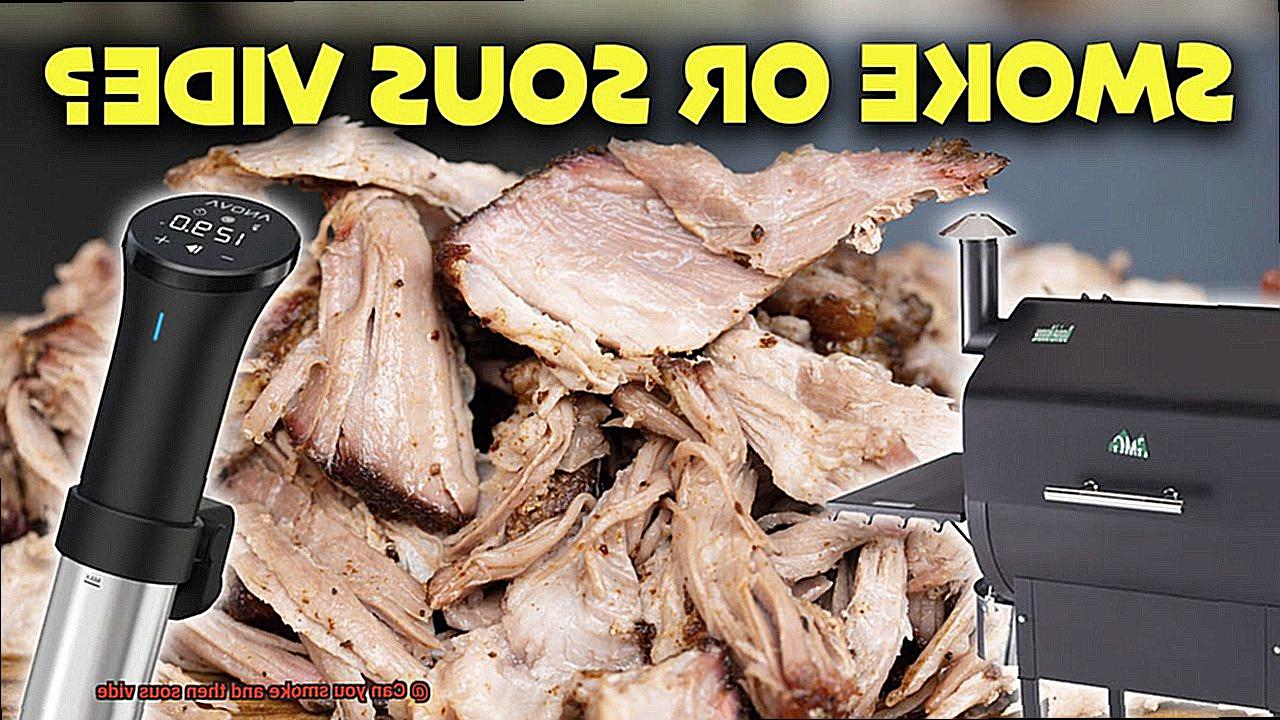
One thing to keep in mind is that smoking can create a barrier on the surface of your meat, which can prevent it from properly absorbing your sous vide marinade or seasoning. To avoid this issue, I recommend lightly seasoning or marinating your meat before smoking it. This will ensure that the flavors penetrate deep into the meat, resulting in a more flavorful dish.
In summary, smoking before sous vide cooking can enhance the overall flavor profile of your meat but may also impact cook time. To achieve juicy and tender results, consider the thickness of your meat and desired internal temperature when determining sous vide cook times. And don’t forget to lightly season or marinate your meat before smoking it to avoid any barriers from forming.
Food Safety Considerations
While these techniques can enhance the taste of your food, it’s important to take food safety considerations seriously. As an expert in this area, I have some tips to help you achieve mouthwatering results without compromising your health.
Smoking meat can introduce harmful bacteria such as E. coli and Salmonella if not cooked properly. To ensure safety, cook your meat to an internal temperature of at least 145°F for beef, pork, and lamb, and 165°F for poultry. It’s also imperative to maintain proper temperature control during the smoking process to prevent bacteria growth.
Sous vide cooking involves cooking food in a vacuum-sealed bag at a low temperature for an extended period of time. This technique can create an environment that is conducive to the growth of harmful bacteria. Therefore, it’s crucial to cook your food to the appropriate internal temperature and time to eliminate any potential risks.
To combine smoking and sous vide cooking safely, there are two approaches you can take. First, smoke the meat at a high enough temperature to kill any potential harmful bacteria before vacuum-sealing it for sous vide cooking. Second, sous vide cook the meat first before finishing it off with a quick smoke on a grill or smoker.
In addition to these approaches, there are other food safety considerations you should keep in mind when experimenting with these techniques. Here are some tips:
- Wash your hands and surfaces often to prevent cross-contamination.
- Use clean utensils and equipment throughout the cooking process.
- Monitor temperatures closely during both smoking and sous vide cooking.
- Store smoked or sous vide-cooked meats properly in the refrigerator or freezer.
By following these guidelines, you can enjoy flavorful smoked and sous vide-cooked meats while minimizing any potential health risks.
Tips for Successful Smoked-Then-Sous-Vided Meats
Combining smoking and sous vide techniques can create an explosion of flavor that will make your taste buds dance with joy. However, it’s important to keep in mind that smoking and sous vide are two very different cooking methods, and they each require their own unique techniques and considerations when used together. Here are 5 key tips to keep in mind when cooking smoked-then-sous vided meats:
Choose the Right Cut of Meat
The cut of meat you choose is essential to keeping your meat moist and tender throughout the cooking process. Opt for cuts that have a higher fat content, such as ribeye or brisket. These cuts will hold up better during the smoking process and retain moisture during sous vide cooking.
Don’t Overdo It on the Smoke
While a smoky flavor is desirable, too much smoke can overpower the other flavors in the dish and cause bitterness. Use a gentle smoking method and monitor the internal temperature of the meat closely to achieve a balanced flavor profile.
Properly Season and Vacuum Seal
To ensure even cooking and a tender, juicy texture, properly season and vacuum seal the meat before placing it in the sous vide bath. This will help prevent any air pockets from forming and ensure that the meat cooks evenly.
Consider Timing
Timing is everything when it comes to smoking-then-sous-vided meats. Smoking time will vary depending on the type of meat and your desired level of smokiness, while sous vide cooking time will vary based on factors like the thickness of the meat and your desired level of doneness. Be sure to follow recommended temperature and time guidelines for your specific cut of meat.
Be Patient
Smoking-then-sous-vided meats require a significant amount of time and effort, so be prepared to invest some serious time and energy into the process. But trust us, the end result is worth it – perfectly cooked, tender meat that is full of flavor. When finishing off the meat after sous vide cooking, only cook it for a short amount of time to give it a nice sear and finish off any remaining fat – overcooking at this stage can undo all of your hard work from earlier in the process.
Different Types of Smoked Meats that Can Be Sous Vided
Smoking and sous vide cooking are two techniques that can elevate the flavor of meat and vegetables. Combining these methods can create mouth-watering dishes that are tender and juicy. In this post, we’ll delve into the different types of smoked meats that can be sous vided and offer some tips for achieving the best results.
Beef Brisket
Beef brisket is a classic choice for smoking before sous vide cooking. The tough collagen in the meat breaks down when smoked slowly over low heat, resulting in a juicy and tender texture. Once the brisket has been smoked, it can be vacuum-sealed and cooked sous vide at a low temperature for several hours to further tenderize the meat. The result is a delectable dish that’s rich in flavor.
Pork Shoulder
Pork shoulder is another popular choice for smoking before sous vide cooking. Slow smoking the pork shoulder imparts it with rich smoky flavor, while sous vide cooking ensures even cooking and moisture retention. The end result is succulent pulled pork that’s perfect for sandwiches or tacos.
Ribs
Ribs are a great option for smoking before sous vide cooking. Slow smoking over low heat renders the fat and breaks down the connective tissue, resulting in velvety, flavorful meat. After smoking, the ribs can be vacuum-sealed and cooked sous vide at a low temperature for several hours to further enhance their tenderness and flavor.
Salmon
Smoked salmon is a delicacy that’s enjoyed worldwide. Smoking salmon adds depth to its delicate texture by introducing a rich, smoky flavor. Once smoked, the salmon can be vacuum-sealed and cooked sous vide at a low temperature to maintain its moisture and tenderness.
Chicken
Smoked chicken is another delicious option for sous vide cooking. The smoky flavor adds depth to the chicken’s mild taste, while sous vide cooking preserves its juiciness and tenderness. After smoking, chicken can be vacuum-sealed and cooked sous vide at a low temperature for several hours to enhance its flavor and texture.
Vegetables
Vegetables like eggplant or portobello mushrooms can also benefit from smoking before sous vide cooking. Smoking imparts them with a unique, smoky flavor that complements their earthy taste. Once smoked, they can be vacuum-sealed and cooked sous vide at a low temperature to achieve the desired texture.
It’s important to keep in mind the safety measures when combining smoking and sous vide cooking. Ensure that the meat is fully cooked to the appropriate temperature before serving, especially if it has been smoked and then cooked sous vide. Follow proper food handling procedures throughout the cooking process to prevent cross-contamination and ensure the safety of your guests.
IfOO7L2h4ig” >
Conclusion
In conclusion, the combination of smoking and sous vide cooking can elevate your culinary game to new heights. Smoking infuses the meat with a rich, smoky flavor, while sous vide ensures that it is cooked evenly and retains its moisture. However, there are several factors to consider when using these techniques together, such as choosing the right wood chips or charcoal, monitoring smoking time, and ensuring food safety.
To achieve succulent results when smoking before sous vide cooking, select a cut of meat with higher fat content and avoid over-smoking it. Proper seasoning and vacuum sealing before placing in the sous vide bath are also crucial for maximum flavor. Timing is key in achieving the perfect texture and taste. Beef brisket, pork shoulder, ribs, salmon, chicken or vegetables like eggplant or portobello mushrooms can all be smoked before being cooked sous vide for an incomparable taste experience.
Nonetheless, food safety should always be prioritized when combining these methods. Cooking your meat to a safe internal temperature is essential to eliminate any harmful bacteria. To ensure that you’re following recommended temperature guidelines for your specific cut of meat and monitoring temperatures closely during both smoking and sous vide cooking will help you achieve delicious smoked-then-sous vided meats without compromising your health or sacrificing flavor.

